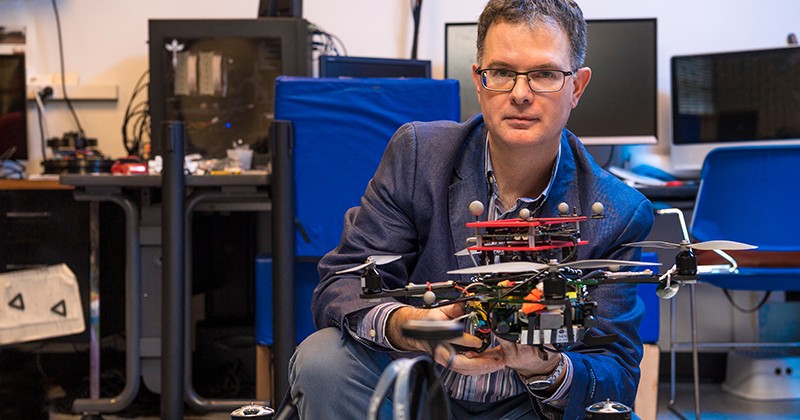Center for Autonomous and Robotic Systems to galvanize robotics research at UD
The University of Delaware is becoming a leading destination for cutting-edge robotics and autonomy research, thanks in part to the new Center for Autonomous and Robotics Systems (CARS), which launched earlier in 2020.
Experts in the CARS center are studying robotics, systems and control and autonomous systems and artificial intelligence with applications for health, the environment and more. They are also studying the ethical, legal and societal impacts of their work.
Led by Bert Tanner, a professor of mechanical engineering, the new research center establishes a focal point for robotics research at UD and promotes collaborative, interdisciplinary work among the university’s already robust network of robotics and systems experts. Faculty and students at UD are studying robotics for use in environmental monitoring, rehabilitation, agriculture, smart vehicles, and much more.
“Over time, we developed collectively a tremendous potential for impact on the field, but we were dispersed around campus, and interdisciplinary collaboration was happening organically, but through personal relationships and networks,” said Tanner. “The intention of the center is to provide a platform and a set of resources to nourish such interactions, allow them to grow, and increase their reach and visibility.”

This photograph was taken before the coronavirus (COVID-19) pandemic forced the need for social distancing and the wearing of masks. UD researchers are using robotics to study the roots of corn plants. From left to right are Erin Sparks, assistant professor of plant and soil sciences; Adam Stager, doctoral student of mechanical engineering; and Teclemariam (Tecle) Weldekidan, research scientist in plant and soil sciences.
The mission of the CARS center is to support UD faculty and students and facilitate their efforts to improve the community’s quality of life and working conditions through innovative and collaborative research on robotic and other cyber-physical systems, which can interact physically with their environment as well as cognitively with humans.
According to Deputy Director Art Trembanis, a professor of oceanography, “the CARS center will help catalyze robotics activity across many disciplines and translate that knowledge into solutions for society and for commercial partners.” Noting the role of CARS as a talent hub. Trembanis explained that “by drawing on expertise from throughout the entire UD system and leveraging our existing resources and central proximity in the Mid-Atlantic Bight makes CARS an ideal partner for industry and federal agency partners looking to advance the field of robotics.” (When talking about oceanography, a bight is a long, gradual bend or recess in the shoreline.)

Center member Fabrizio Sergi, an assistant professor of biomedical engineering, develops new robots and tools to elucidate the physiology of human motor control.
The CARS center has already received its first grant, through the U.S. Army’s Scalable, Adaptive and Resilient Autonomy program. The project is about enabling the Army’s ground robots to navigate autonomously (minimal to no human intervention) through forest environments.
Guoquan (Paul) Huang, associate professor of mechanical engineering, is the principal investigator; Tanner is the co-principal investigator. Huang is leading vehicle calibration and localization research efforts, while Tanner is working on the motion planning side of the problem. They are bringing their expertise together to improve the Army’s capabilities.

This 3D colored illustration shows depth measurements collected over craters at Bikini Atoll. In 2019, Professor Art Trembanis led a team conducting an underwater mapping effort to locate and characterize the ghost fleet that sits on the bottom of the Pacific as well as the landscape of the atoll in general.
The new center will complement research in other centers and institutes at UD, including the Data Science Institute (DSI). Collaborations with DSI at the center level are already on the way.
For students who want to design, build and program the robots of the future, UD offers a master of science in robotics, which is expected to complement the research activities of CARS and be able to benefit from the increased exposure and additional instructional resources that CARS will offer.
The CARS center’s advisory board includes Josh Broussard, chief technology officer at Ocean Infinity; Vijay Kumar, dean of the University of Pennsylvania School of Engineering and Applied Science; Lydia Kavraki, director of the Ken Kennedy Institute at Rice University; and Magnus Egerstedt, Steve W. Chaddick School Chair and Professor in the School of Electrical and Computer Engineering at the Georgia Institute of Technology.
For more information and to get involved, visit robotics.engr.udel.edu.

In the laboratory of Guoquan Huang, an associate professor of mechanical engineering, researchers study ways to localize a robot and track a moving target.

